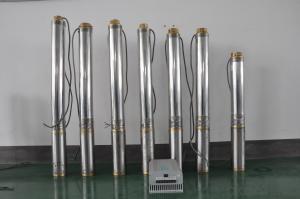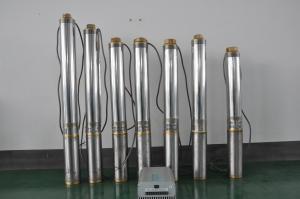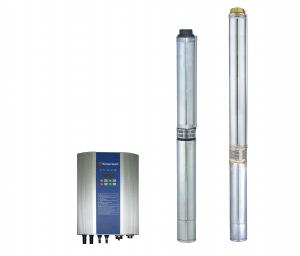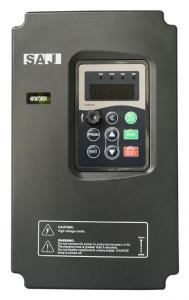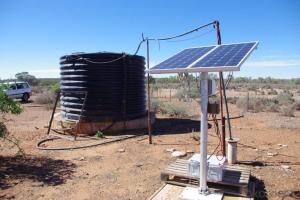Solar pump inverter FCPM100KH
- Loading Port:
- China Main Port
- Payment Terms:
- TT OR LC
- Min Order Qty:
- -
- Supply Capability:
- -
OKorder Service Pledge
Quality Product, Order Online Tracking, Timely Delivery
OKorder Financial Service
Credit Rating, Credit Services, Credit Purchasing
You Might Also Like
Solar pump inverter FCPM75KH Product Description:
Solar water pumping system is constructed with solar panel array,solar pump inverter and AC water pump, DC current produced from solar panel will be delivered to solar pump inverter,and it will convert it into AC current to drive water pump,and will automatically regulate output frequency according to sun radiance intensity,maximally realize MPPT tracking function.
Features
Adopting the proposed dynamic VI maximum power point tracking (MPPT) control method, with fast response, and reliable operation, achieves efficiency of 99%.
Designed with variable frequency driver, greatly improves efficiency
Extremely high efficiency
Digital mode control, with automatic operation and manual operation mode options
Complete protection functions
Adopts intelligent IPM module, with high reliability
LCD display and operation panel, in real time presents operating data
Optional for water level measurement and control circuit
Applicable for general ACC pumps, like centrifugal pump, piston pump etc.
Independent intellectual property; Highly effective, the redundant reliability, exempts the maintenance and the long life.
The pumps are soft started, fully protected.
No batteries are used. So better Sunlight, more water.
Datasheet.

- Q:What is the role of solar water pump?
- Solar water pump itself, reliable: photovoltaic power rarely used to move parts, reliable work.
- Q:How does the presence of shading affect the performance of a solar pump system?
- The presence of shading can significantly impact the performance of a solar pump system. Shading on even a small portion of the solar panels can greatly reduce the overall efficiency of the system by reducing the amount of sunlight reaching the panels. This decrease in sunlight can decrease the power output of the system, leading to reduced pump performance and potentially even complete shutdown in certain conditions. Therefore, minimizing shading and ensuring that the panels receive maximum sunlight is crucial for optimal performance of a solar pump system.
- Q:Are there different types of solar pumps available?
- Yes, there are different types of solar pumps available. Some common types include submersible solar pumps, surface solar pumps, and floating solar pumps. These pumps are designed for various applications such as irrigation, water supply, and fountain systems, and they vary in terms of capacity, efficiency, and installation requirements.
- Q:Can a solar pump be used for irrigation in agricultural fields?
- Irrigation in agricultural fields can be accomplished using a solar pump. This type of irrigation system harnesses solar energy to power the pump, which retrieves water from sources like wells, rivers, or ponds and transports it to the fields. This system proves especially advantageous in remote areas with limited or unreliable access to electricity. When it comes to agricultural irrigation, solar pumps boast numerous benefits. Firstly, they are more environmentally friendly compared to traditional diesel or electric pumps since they neither emit greenhouse gases nor rely on fossil fuels. Furthermore, solar pumps boast low maintenance costs and prove cost-effective in the long run by eliminating the need for fuel or electricity payments. Moreover, solar pumps ensure a dependable and consistent water supply for irrigation, guaranteeing crops receive the necessary water for growth and productivity. These pumps can be designed to operate automatically based on sunlight availability and can incorporate sensors and control systems to optimize water usage and minimize waste. To conclude, solar pumps offer a sustainable and efficient solution for agricultural field irrigation. They provide a clean and renewable energy source, reduce operational costs, and deliver a reliable water supply for crop irrigation.
- Q:What is the impact of a solar pump on rural development?
- A solar pump has a significant impact on rural development. It provides a reliable and sustainable source of water for irrigation, livestock, and household needs, thereby improving agricultural productivity and food security in rural areas. It reduces the dependence on traditional manual methods of water extraction, which are labor-intensive and time-consuming. Moreover, solar pumps decrease the reliance on fossil fuels or grid electricity, reducing costs and promoting environmental sustainability. The availability of water through solar pumps also enables the development of small-scale industries, such as fish farming and vegetable cultivation, which further contribute to rural economic growth. Overall, solar pumps play a crucial role in enhancing livelihoods, increasing income opportunities, and improving overall living conditions in rural communities.
- Q:What is the maximum elevation a solar pump can pump water to?
- The maximum height that a solar pump can lift water to relies on several factors such as the solar panel's power and efficiency, the pump's capacity and pressure, and the distance and height difference between the water source and the desired destination. Generally, solar pumps can lift water to heights ranging from a few meters to several hundred meters. It is important to consider that as the height increases, the pumping capacity of the solar pump may decrease due to gravity and friction in the pumping system. Moreover, the efficiency of the solar panel may be affected by shading, orientation, and weather conditions, which can further impact the pump's maximum lifting height. To determine the specific maximum height a solar pump can reach, it is advisable to refer to the manufacturer's specifications and guidelines for the particular model being used. Additionally, seeking advice from a professional or a solar pump expert can assist in accurately assessing the maximum lifting capabilities based on the specific requirements and conditions of the pumping system.
- Q:Can a solar pump be used for water supply in a commercial kitchen or food processing facility?
- Yes, a solar pump can be used for water supply in a commercial kitchen or food processing facility. Solar pumps are efficient and environmentally friendly alternatives to traditional electric pumps, providing a sustainable solution for water supply needs. They can effectively deliver water for various purposes such as cooking, cleaning, and food processing, while reducing energy costs and carbon emissions.
- Q:Is it possible to store excess solar energy generated by the pump?
- Yes, it is possible to store excess solar energy generated by the pump. One common method of storing excess solar energy is through the use of batteries. These batteries can store the excess energy generated during the day and then release it during periods when the pump is not generating enough energy, such as at night or during cloudy days. Additionally, other energy storage technologies such as thermal energy storage or hydrogen fuel cells can also be used to store excess solar energy for later use by the pump. These storage solutions allow for a more efficient and reliable use of solar energy, ensuring that the pump can operate even when there is no direct sunlight available.
- Q:Can a solar pump be used for geothermal heating and cooling systems?
- No, a solar pump cannot be used for geothermal heating and cooling systems. Geothermal systems require specialized pumps designed to handle the unique requirements of extracting heat from underground sources, while solar pumps are primarily used for circulating water in solar water heating systems or for irrigation purposes.
- Q:How does the size of the pump motor affect the performance of a solar pump?
- Determining the performance of a solar pump heavily relies on the size of the pump motor. The flow rate, pressure, and overall efficiency of the pump are directly influenced by the motor size. When the pump motor is larger, it enables a higher flow rate, resulting in the ability to pump more water within a given time period. This is particularly important in scenarios where a substantial amount of water needs to be transported, such as in agricultural irrigation or large-scale water supply systems. A higher flow rate guarantees the effective and efficient delivery of the desired volume of water. Moreover, the size of the pump motor impacts the pump's ability to generate pressure. A larger motor is capable of creating higher pressure, which becomes necessary when pumping water to elevated areas or overcoming resistance in an extensive pipe network. The increased pressure ensures that water reaches its intended destination with sufficient force and can be evenly distributed across the irrigation system or other applications. Furthermore, a larger motor often leads to improved efficiency. With a more powerful motor, the pump requires less time to complete its pumping cycle, resulting in reduced energy consumption. This not only saves costs but also promotes a more sustainable utilization of solar energy. It is important to note that while a larger motor generally offers better performance, it also demands more energy to operate. Therefore, it is crucial to find a balance between motor size and energy availability. If the solar array providing power to the pump cannot generate enough electricity to operate a larger motor, it may be necessary to opt for a smaller motor that can still meet the required performance levels without exceeding the available energy supply. To conclude, the size of the pump motor significantly impacts the performance of a solar pump. A larger motor allows for higher flow rates, increased pressure, and improved efficiency. However, it is essential to consider the available energy supply when selecting the motor size to ensure optimal performance and energy utilization.
1. Manufacturer Overview |
|
|---|---|
| Location | |
| Year Established | |
| Annual Output Value | |
| Main Markets | |
| Company Certifications | |
2. Manufacturer Certificates |
|
|---|---|
| a) Certification Name | |
| Range | |
| Reference | |
| Validity Period | |
3. Manufacturer Capability |
|
|---|---|
| a)Trade Capacity | |
| Nearest Port | |
| Export Percentage | |
| No.of Employees in Trade Department | |
| Language Spoken: | |
| b)Factory Information | |
| Factory Size: | |
| No. of Production Lines | |
| Contract Manufacturing | |
| Product Price Range | |
Send your message to us
Solar pump inverter FCPM100KH
- Loading Port:
- China Main Port
- Payment Terms:
- TT OR LC
- Min Order Qty:
- -
- Supply Capability:
- -
OKorder Service Pledge
Quality Product, Order Online Tracking, Timely Delivery
OKorder Financial Service
Credit Rating, Credit Services, Credit Purchasing
Similar products
New products
Hot products
Hot Searches
Related keywords











